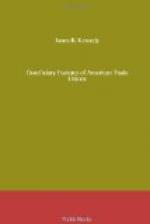[Footnote 4: The dates given indicate the years in which the unions first succeeded in adopting national benefits of some kind, and not the dates on which successful systems were inaugurated. For example, the Cigar Makers’ system of travelling loans adopted in 1867 and its “endowment plan” adopted in 1873 were unsuccessful and the present system was not adopted until 1880. (Cigar Makers’ Journal and Program, twentieth session, pp. 57-63.)]
It is maintained that the establishment of beneficiary features is a direct aid to a union in carrying through its trade policies. In the first place, successful systems of benefits, whether they attract members or not, undoubtedly retain them. Sharp and sudden declinations in membership during industrial disturbances are thus prevented. The effect of the panic of 1893-1897 was peculiarly instructive in this respect. Many labor unions suffered a considerable decline in members. The Typographical Union lost about ten per cent. of its membership, the Brotherhood of Carpenters about fifty per cent., while the Cigar Makers with a highly developed system of benefits lost only one and one half per cent. The trade unionists naturally regard it as peculiarly desirable that the members should not abandon the organization when the difficulty of maintaining wages and conditions is greatest. To hold in hard times what has been gained in good times is a vital point in trade-union policy. The trade unionists realize that the chief work of the unions is not so much in advancing wages in good times as in preventing recessions when employment is scarce. President Strasser of the Cigar Makers has pointed out that the Cigar Makers came through the depression of 1893-1897 with very slight reductions in wages. This result he attributed to the beneficiary system which held the membership in good standing.[5]
[Footnote 5: Cigar Makers’ Journal, Vol. 26, September, 1901.]
It is, of course, impossible to estimate with any degree of precision the effect of trade-union benefits in retaining members. Certain unions, such as the Cigar Makers and the Typographia, having compact organizations with highly developed systems of benefits lose almost none of their membership in periods of depression. The experience of the Cigar Makers is peculiarly instructive since we are here able to note the effect due to the introduction of a system of benefits. In 1869 the membership of the union was 5800. No benefits were paid except the strike benefit. In 1873 the membership had fallen to 3771, in 1874 to 2167, in 1875 to 1604, and in 1877 to 1016. A noticeable increase set in about 1879 and by 1883 the number of members was 13,214.[6] In the depression extending from 1893 to 1897 the membership of the Cigar Makers remained almost stationary. The following table shows the number of members for each year from 1890 to 1900:




